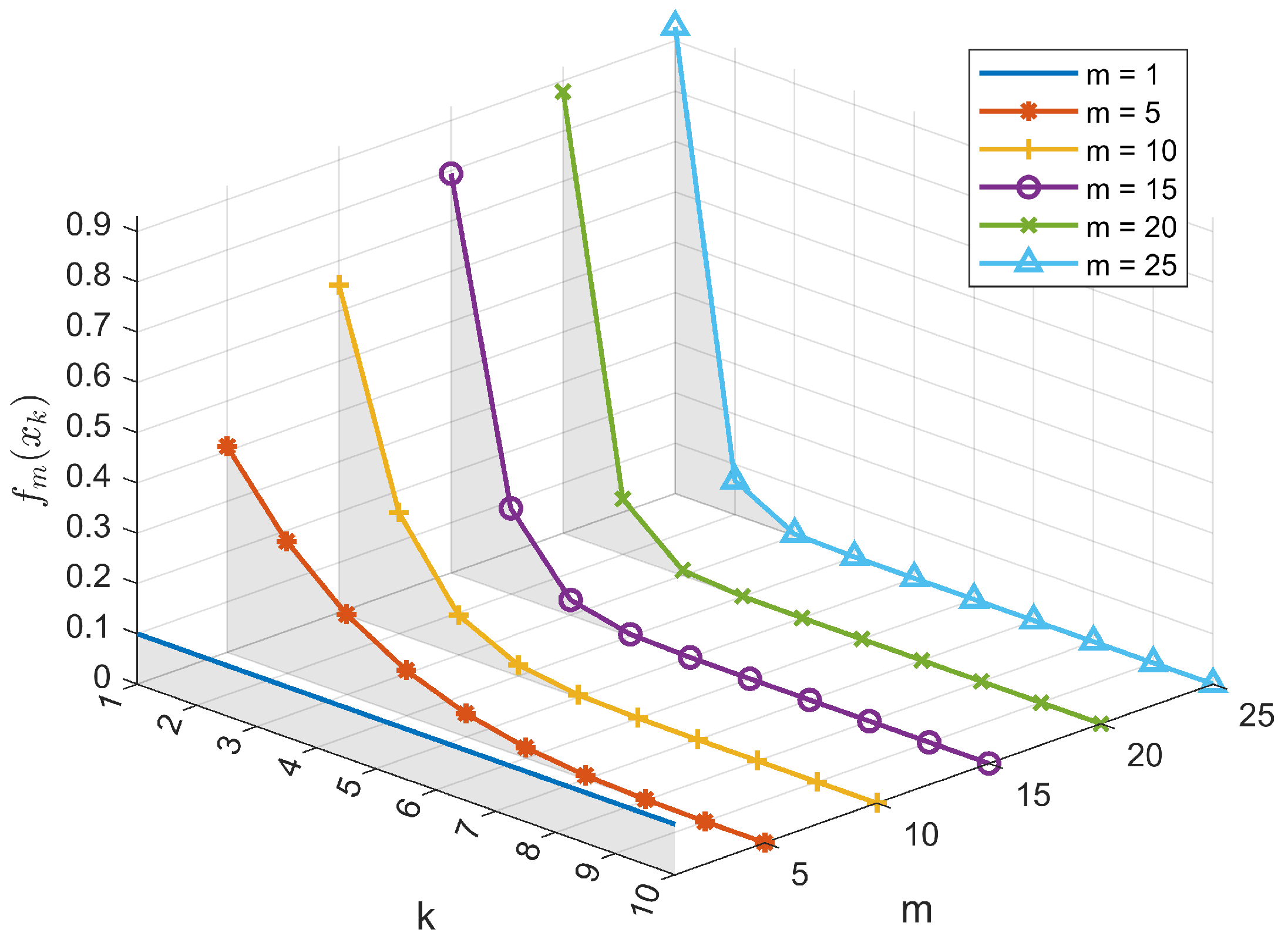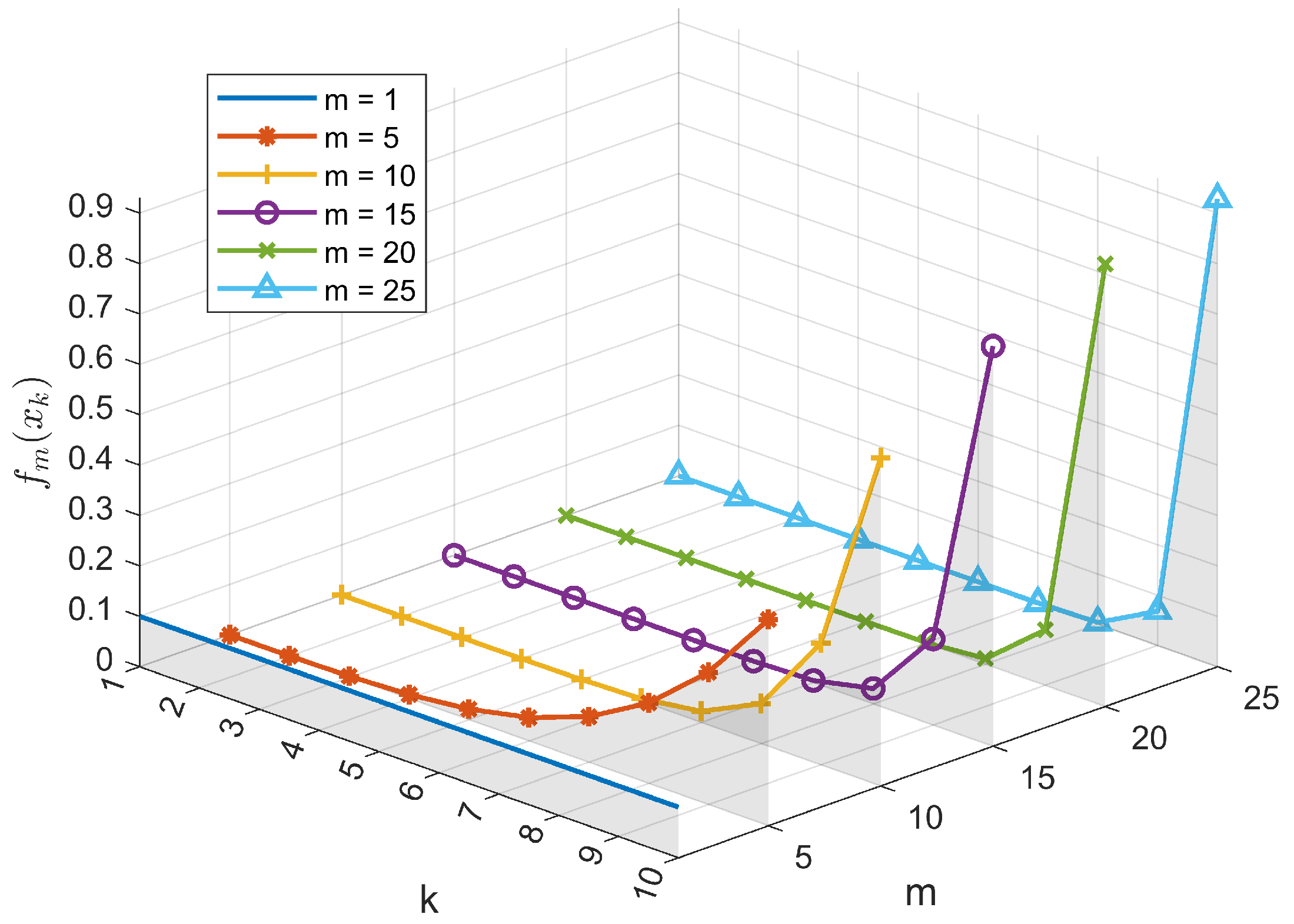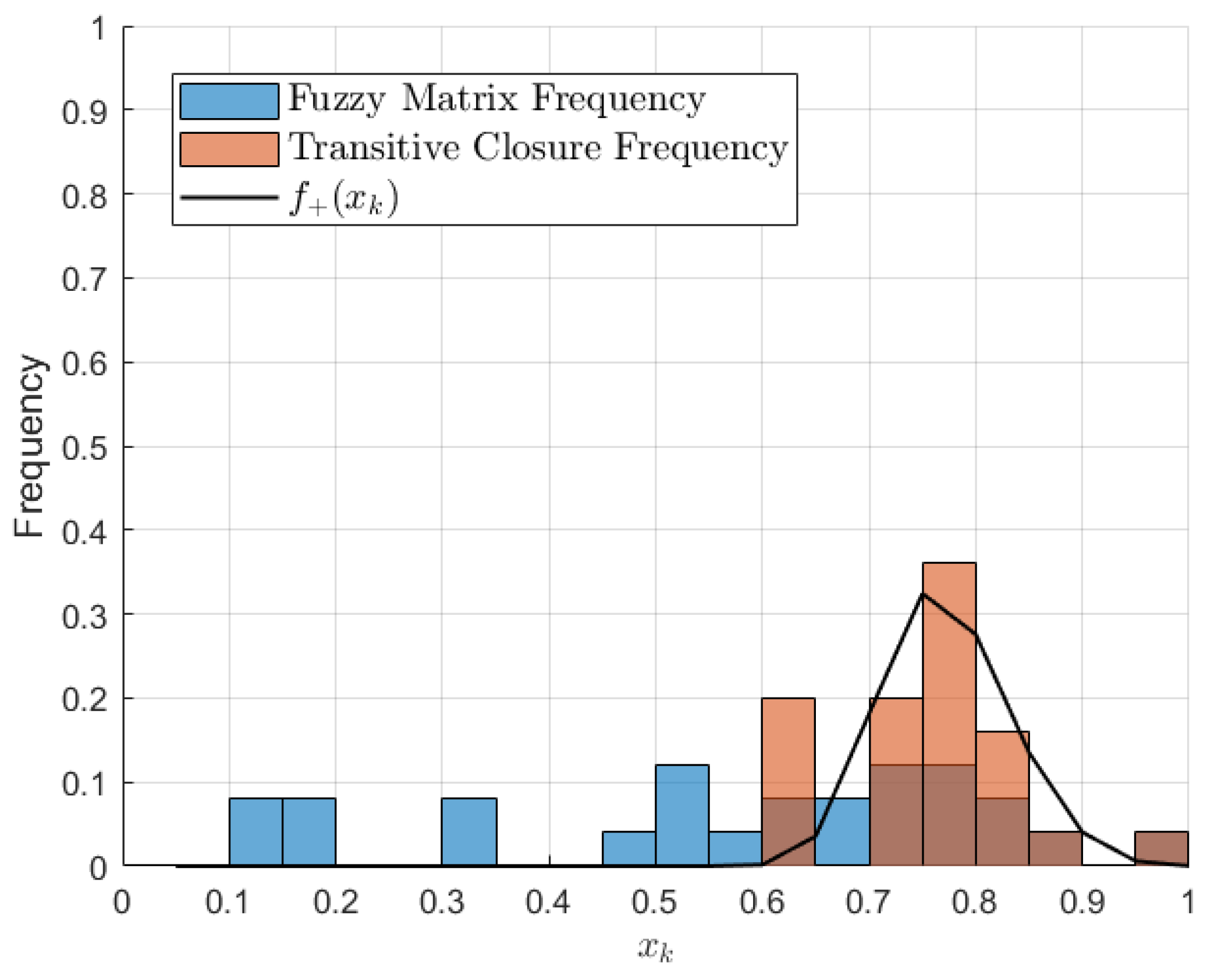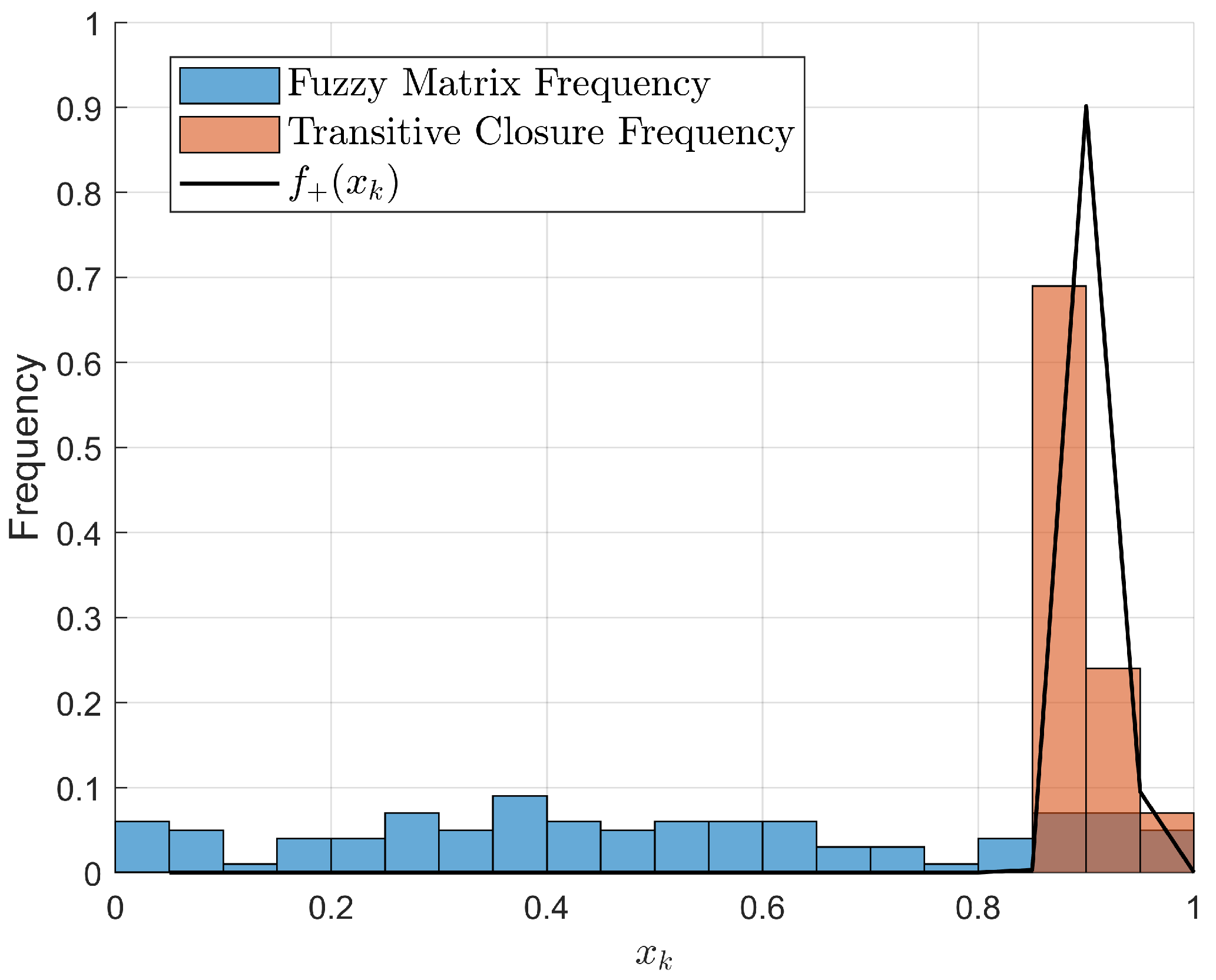Extensive experimental results indicate that the probability distribution of a superposed fuzzy matrix is closely related to that of its transitive closure. This section begins with the simplest case—Bernoulli-type superposed fuzzy matrix—and explores the probability distribution of its superposed transitive closure. Interestingly, the expected value of the superposed transitive closure of any discrete superposed fuzzy matrix tends to converge to the maximum value of the random variables.
3.1. Bernoulli-Type Superposed Fuzzy Matrices
Recall a Bernoulli trial: the probability of failure is , and the probability of success is p. In this paper, we modify the trial outcome to two possible membership degrees, where the probability of obtaining membership degree is , and the probability of obtaining membership degree is p.
Consider a random variable
with
and a superposed fuzzy relation
over the set
, where the probability distribution function
where
. Then
is called “Bernoulli(-type) superposed fuzzy relation”. For simplicity, we write the Bernoulli superposed fuzzy relation as
Here, is the short form of for any . Note that this abbreviation originates from the fact that superposed fuzzy relations are independent of the elements within the set .
Proposition 3. Consider the two Bernoulli superposed fuzzy relations and . We have The proof is based on Proposition 1 and omitted here.
Note that and . This means that the “∧” operation will bias the distribution of the superposed fuzzy relations towards the smaller value, and the “∨” operation will bias the distribution towards the larger value. These are also the expected results.
Proposition 4. For a Bernoulli superposed fuzzy relation , its max–min m-th power can be calculated by the following equations, respectively: Next, we will present the probability distribution of the (superposed) transitive closure of Bernoulli superposed fuzzy matrices.
Theorem 1. For a Bernoulli superposed fuzzy matrix , where , its transitive closure is Through Theorem 1, we can see that the probability distribution of the transitive closure of the Bernoulli superposed fuzzy matrix exhibits a strong bias toward larger values due to the presence of the double exponent. This phenomenon becomes more validated as the matrix dimension increases. Intuitively, with the growth of the matrix dimension, the transitive closure gradually absorbs the smaller values in the original fuzzy matrix, leaving only the larger ones. This is an expected result. We illustrate this phenomenon with an example.
Example 2. For a Bernoulli superposed fuzzy relation, with . Its superposed fuzzy matrix is (N=5), as follows: Consider the probabilistic fuzzy matrix , as follows: In this example, we examine how the proportions of elements (0.8 and 0.2) in the transitive closure of a fuzzy matrix evolve as the size increases. The matrix is generated using a probabilistic mapping, where each element is either 0.8 with a probability of p or 0.2 with a probability of , where p is a predefined threshold probability in the following. The proportion of 0.8 and 0.2 elements in the transitive closure is recorded for different fuzzy matrix sizes (N), ranging from 10 to 200.
The results, illustrated in Figure 1, show that as the size of a fuzzy matrix increases, the relative proportions of these elements converge towards distinct values. We can see that even though the proportion of 0.8 elements in the initial fuzzy matrix is very small (only 5%), the proportion of 0.8 in the transitive closure of the fuzzy matrix increases significantly and approaches 1 as the matrix size grows. Meanwhile, the proportion of 0.2 decreases significantly, with its occurrence probability approaching 0. This result confirms the correctness of Theorem 1. We also draw an accurate probability distribution function curve in Figure 1, i.e., Equation (33). It can be seen that it is almost consistent with the simulation results. This error is due to randomness in the computer. Next, we will calculate the expected value of the superposed transitive closure of the Bernoulli-type superposed fuzzy matrix.
Theorem 2. Consider a Bernoulli-type superposed fuzzy matrix , where , . Then the expectation of its superposed transitive closure is The proof is obtained by routine calculation based on Equation (
12).
It can be observed that the expected value tends toward the maximum value because the second term of Equation (
37) becomes a negligible number when
N is large. The expected value plays a crucial role in the approximation algorithm for large-scale probabilistic fuzzy matrix transitive closures discussed in the following.
3.2. Classical Probability Superposed Fuzzy Matrices
Theorem 3. Let be a discrete random variable. Suppose that is any superposed fuzzy relation; its min–max m-th power can be computed by the following equations: Based on Equations (
38) and (
39), we can derive the following theorem.
Theorem 4. Let be a discrete random variable. For a probability fuzzy matrix , its m-th power can be computed by the following equation:where and . In traditional fuzzy matrix theory, for any . However, a stricter result holds for superposed fuzzy matrices. Due to the double-exponential nature of the probability distribution in the powers of superposed fuzzy matrices, when the matrix dimension is sufficiently large, for any .
Theorem 5. For a superposed fuzzy matrix , we havewhen m is sufficiently large. Naturally, for superposed transitive closures of superposed fuzzy matrices, we also have the following theorem.
Theorem 6. For an superposed fuzzy matrix ,when N is sufficiently large. Thus, we can obtain the probability distribution of superposed transitive closures of any discrete superposed fuzzy matrix.
Theorem 7. Let () be a random variable following . For a superposed fuzzy matrix with , the expectation of its transitive closure iswhere . The classical model of probability is one of the earliest and most fundamental approaches to understanding and formalizing randomness and uncertainty, also called discrete uniform distribution. It provides a simple and intuitive framework, especially for discrete and finite systems. In classical probability, the assumption is that all outcomes of an experiment are equally likely. If an experiment can result in
n different outcomes, i.e., random variable
, and each outcome is equally probable, the probability of a particular outcome is given by
for
, where
is the total number of possible outcomes in the sample space of
X. Note that the probability of the occurrence of mutually exclusive events can be computed by summing their individual probabilities.
Let
; then a superposed fuzzy relation
is called a “classical probability superposed fuzzy relation” if
for
.
The classical probability sample space is no longer two. We will give relevant propositions of the case of n.
Therefore, we can obtain the min–max m-th power probability distribution of classical probability fuzzy superposition relation.
Proposition 5. Let ; based on Theorem 3, we haveand Next, we verify the bias of the probability distribution. For
, we first plot the following functions for different
; see
Figure 2.
We can observe that when
,
follows an (discrete) uniform distribution. As
m increases, the probability distribution of
becomes biased towards smaller values. This is an expected result, as the “
” operator increases the probability of smaller values occurring in
while decreasing the probability of larger values. Note that the area of the shaded part is always 1. For
, there is a symmetric result; see
Figure 3.
Next, we present the graph of function
when
. If
, function
is uniformly distributed. As
m increases, function
has a significant biasing effect on the distribution of
, See
Figure 4.
Therefore, and have similar effects on . Both will bias the distribution of toward larger values, although to different extents.
Thus, we can obtain the probability distribution of superposed transitive closures of a classical probability superposed fuzzy matrix.
Theorem 8. For an classical probability fuzzy matrix with , its transitive closure can be computed by the following equation:when N is sufficiently large. We perform simulation verification of “approximately equal” in Equation (
49). Let
We plotted the function
for
,
and
,
; see
Figure 5 and
Figure 6. Then, we constructed a fuzzy matrix using a uniform distribution and recorded the frequency of each element in that matrix. Next, we computed its transitive closure and recorded the frequency of each element in the transitive closure. It is important to note that
N should not be too large, as this could exceed the computational capacity of the computer due to double exponentiation.
We found that the function closely fits the probability/frequency distribution of the elements in the transitive closure. This also confirms that this approximate computation method for the transitive closure is feasible.
At the same time, we also obtain the probability distribution of superposed transitive closure of the classical probability superposed fuzzy matrix.
Proposition 6. Let () be a random variable following uniform distribution. For a classical probability superposed fuzzy matrix , where , the expectation of its transitive closure is 










